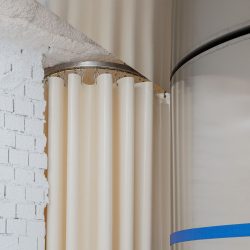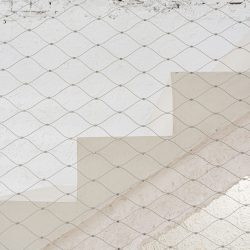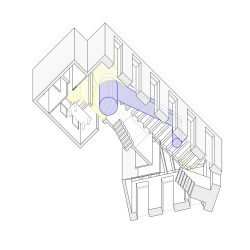
BURR . photos: © Maru Serrano
FVI is the transformation of a disused commercial space in historic Madrid into a space designed to host a variety of activities.
The project aims to create a space that is flexible enough to be programmed in numerous ways, neutral enough to be appropriated by different occupants and representative enough to have its own identity.
The strategy divides the intervention in two: background and figure.
The background assumes the role of becoming a generic, neutral space; something like a white box that can be used for any activity. To this end, the container space is treated to expose its raw materiality, removing the coatings accumulated over the years. Subsequently, it is unified by using white paint applied over the various existing materials and textures. Additionally, a system of curtains occasionally extends this background, allowing certain areas to be activated or deactivated and facilitating the use of the space for simultaneous activities.
The figure is a stainless steel frame that contains all the communal installations, which cross the space vertically, and the installations for climate control, electricity, and plumbing. This element can also be disassembled into different pieces, working as a base for displaying any type of object or product, depending on the activity that should take place around it. The figure is a support structure for the space; a servant element that enables the different uses of this space. At the same time, it becomes the totem that represents the project. In the lower floor, a load-bearing element is introduced, a Warren truss, necessary to structurally reinforce the ground-floor slab. To clearly mark this underpinning intervention, this element is painted yellow to differentiate it from the existing envelope.
FVI is a combination of elements that seek to consolidate, on one hand, a pre-existing early 20th-century building, and on the other hand, a system that aims to facilitate the activities of its users.
_
Architecture: BURR
Team: Amanda Bouzada y Jesús Meseguer.
Lighting consultant: Estudio Dina
Office table and lamp: Caliper
Photography: Maru Serrano.
Licence consultant: García de los Muros.
FVI es la transformación de un local en desuso del Madrid histórico en un espacio para albergar distintas actividades. El proyecto por tanto de generar un espacio suficientemente flexible, como para poder ser programado de muy distintas maneras; suficientemente neutro, como para poder ser apropiado por diferentes ocupantes y suficientemente diferencial, como para tener identidad propia. La estrategia divide la intervención en dos: fondo y figura. El fondo asume el rol de convertirse en ese espacio genérico, neutro, a modo de caja blanca, que pueda ser apropiado por cualquier actividad. Para ello se trata el espacio contenedor, de manera que quede expuesta su materialidad en crudo, quitando los revestimientos acumulados a lo largo de los años. Posteriormente se unifica el espacio mediante a una capa de pintura blanca aplicada sobre los distintos materiales y texturas existentes. Por otra parte se plantea un sistema de cortinas, a modo de fondo expandido, que permite activar o desactivar determinadas áreas y facilitar el uso del espacio con diferentes actividades simultáneas. La figura se crea a partir de una estructura de apoyo, que por una parte de servicio al espacio y por otra tenga capacidad de convertirse en la propia imagen que represente el proyecto. Esta estructura toma forma de pórtico biapoyado de acero inoxidable, que alberga tanto las instalaciones comunitarias preexistentes, que cruzaban verticalmente el espacio, como las instalaciones propias de climatización, electricidad y fontanería. Este elemento servidor está concebido como un puzle, que puede descomponerse en diferentes piezas, funcionando como soporte para la exposición de cualquier tipo de objeto o producto, dependiendo de la actividad desarrollada en el espacio. En la planta inferior, se introduce un elemento portante, una cercha Warren, necesaria para reforzar estructuralmente el forjado de la planta baja. Con el fin de marcar claramente esta intervención de apeo, se pinta este elemento de amarillo, para diferenciarse de la envolvente existente. FVI es por tanto una suma de elementos que tratan de consolidar por una parte un edificio preexistente de principios del SXX y por otra un sistema que trata de facilitar la actividad de sus usuarios.









































